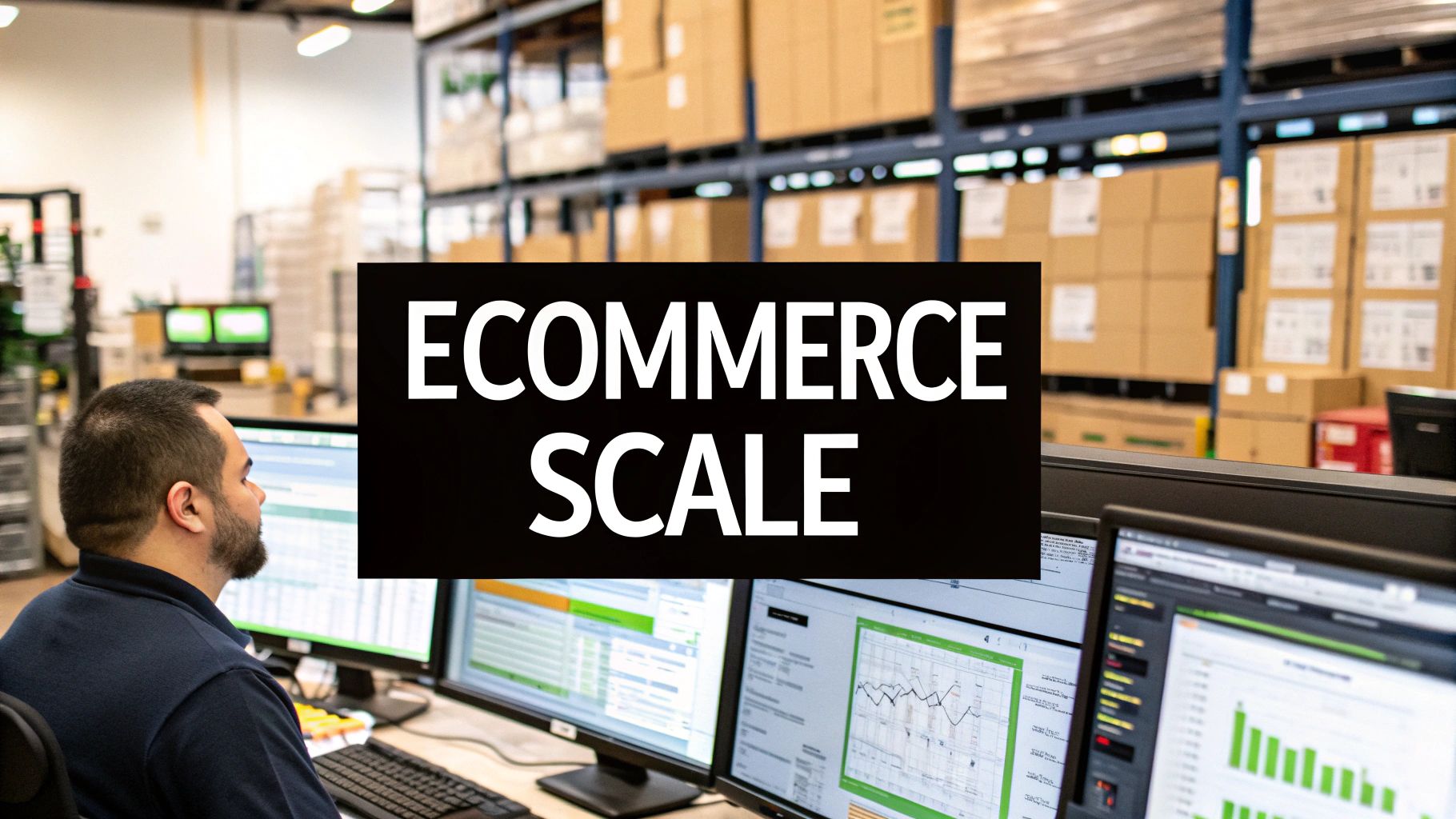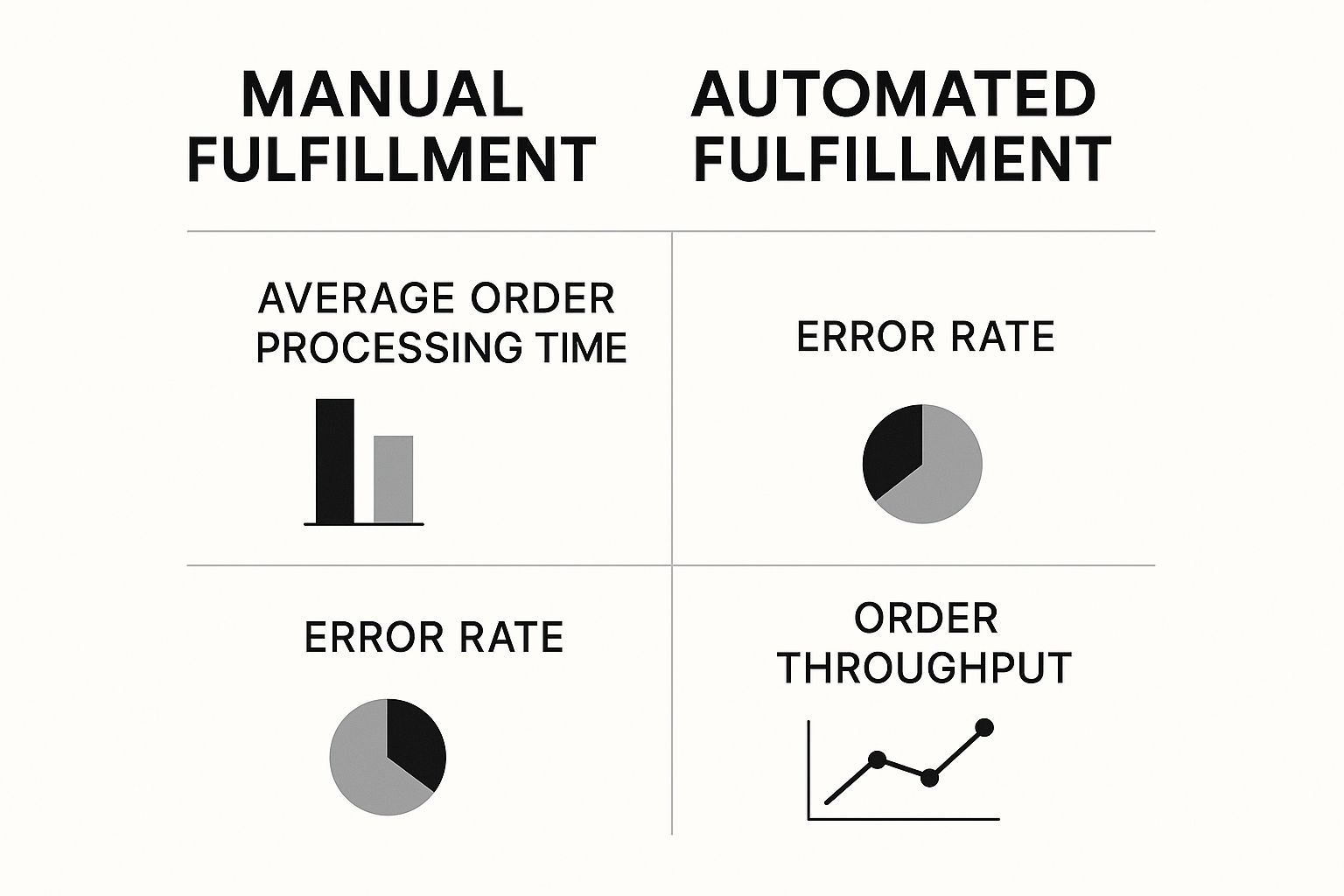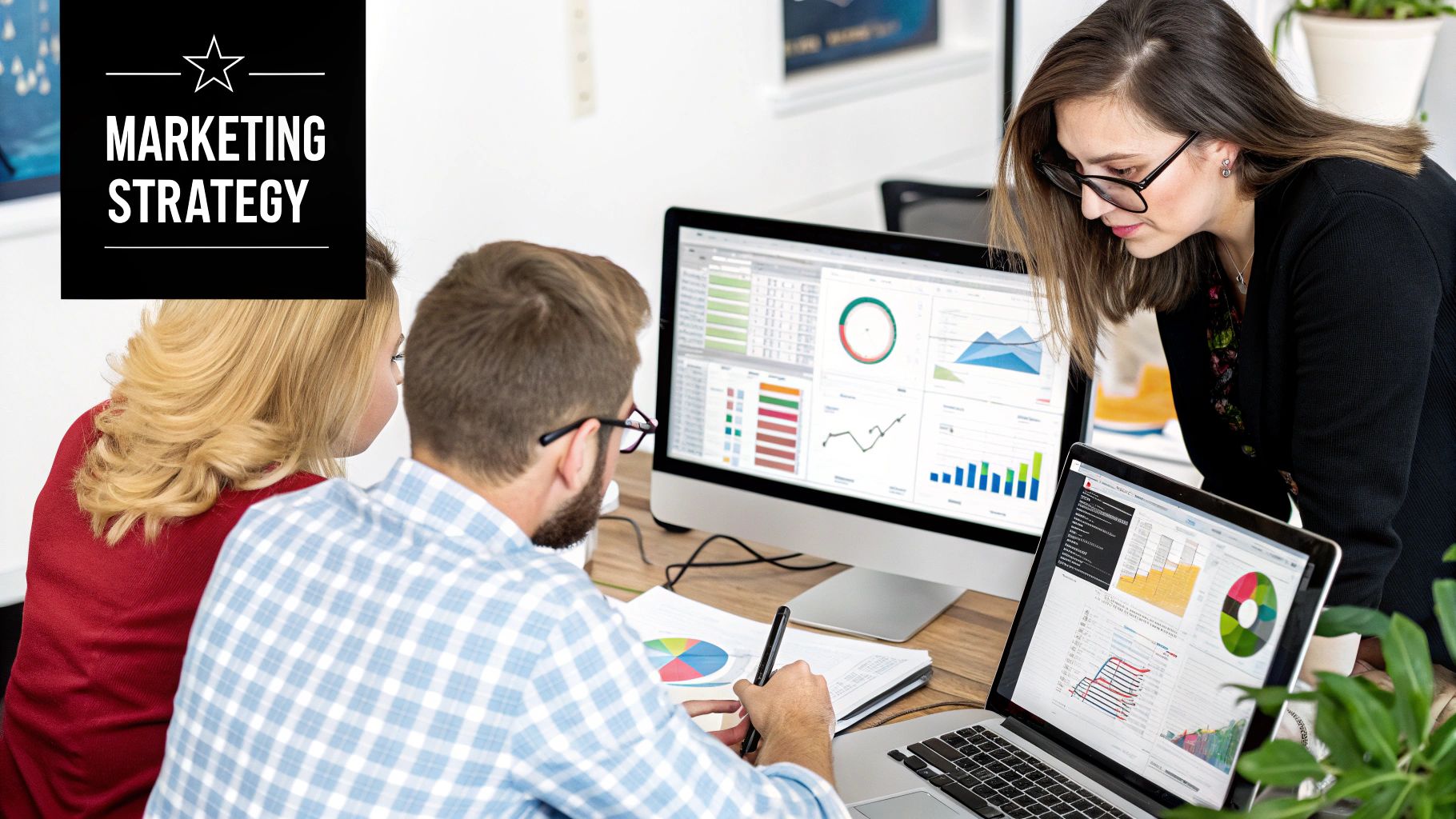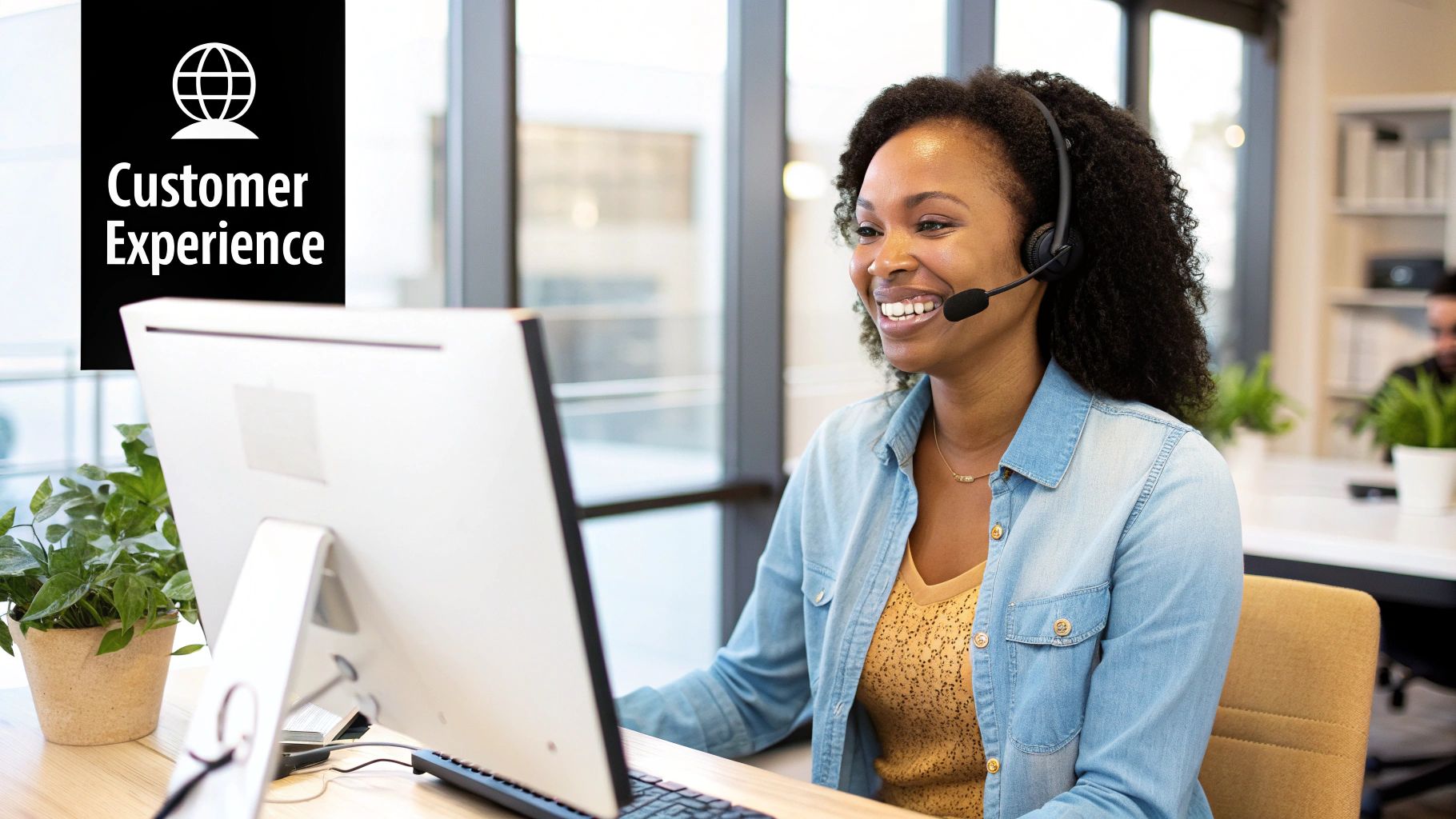Stay Updated with Everything about MDS
Thank you! Your submission has been received!
Oops! Something went wrong while submitting the form.

Chilat Doina
July 18, 2025
Getting past the initial startup grind is the real test when you want to scale your e-commerce brand. It stops being about sheer hustle and starts being about building smart, repeatable systems that drive predictable growth. This means you have to get serious about fine-tuning your marketing, beefing up your tech, locking down your operations, building out your team, and getting a firm grip on your finances.
The leap from a founder-led brand running on fumes and passion to a scalable company requires a huge mental shift. You're not just selling stuff anymore; you're engineering a growth machine. The prize is massive—the global ecommerce market is set to rocket to $8.3 trillion by 2025. A huge chunk of that is happening on our phones, with over 70% of online purchases now made on mobile devices.
To claim your slice of that pie, you need to graduate from daily fire-fighting to long-term strategic planning. This blueprint is all about breaking down the core pillars every ambitious brand needs to build on.
The secret to scaling isn’t trying to do everything at once. It’s about methodically reinforcing the key parts of your business so they can support real growth. Think of it like building a house—each pillar holds up the others.
Here's a quick look at the five core areas we'll be diving into:
I’ve seen so many founders trip up by trying to scale without writing anything down. Your mission should be to create systems and processes so airtight that the business runs like a well-oiled machine, even when you’re not in the weeds every single day.
To give you a clearer picture of how these pillars fit together, here's a simple breakdown of what you should be focusing on.
Each of these pillars is a deep topic on its own, but understanding how they connect is the first step toward building a truly scalable brand.
As you start putting your own growth plan together, having the right tools is a game-changer. If you're on Shopify, checking out a curated list of 10 essential Shopify apps for scaling your store is a great place to start. And for a more comprehensive look at the frameworks we're talking about here, we've put together a full guide on the essentials of scaling an ecommerce business that you'll find really helpful.
Those first few ad campaigns that put you on the map? That’s not a long-term strategy. To really scale an ecommerce brand, you have to move beyond one-off tactics and build a predictable, multi-channel growth engine. This is about evolving past just dumping money into ads and hoping for sales.
The real goal is to create a system where all your marketing channels feed each other, creating a powerful flywheel effect. Think of it this way: smart SEO brings in a steady flow of organic traffic, high-value content builds trust and authority, and targeted email automation turns first-time buyers into loyal fans. You're not just buying growth anymore; you're engineering it.
Look, running ads is a non-negotiable part of the game. But scaling demands a much smarter approach. Just cranking up your ad spend without a solid strategy is one of the fastest ways I’ve seen brands burn through cash. The real magic happens when you make every single visitor count, whether they came from a paid ad or an organic search.
You have to align your ad creative and messaging directly with your landing pages. It sounds simple, but so many get it wrong. If someone clicks an ad for a specific blue jacket, they need to land on the product page for that exact blue jacket—not your homepage or a generic category page. This seamless experience is critical for reducing friction and bumping up your conversion rates.
A classic mistake I see is treating all traffic as if it's the same. A visitor from a retargeting ad is miles ahead in intent compared to someone who found you through a "how-to" blog post. Your job is to meet them exactly where they are and gently guide them to the next logical step.
Once they're on your page, don't stop there. Hit them with social proof, make your return policy impossible to miss, and feature user-generated content from happy customers. All of this builds instant trust and gives visitors more reasons to pull the trigger, turning that expensive click into a profitable sale.
Still sending the same generic email blast to your entire list? That’s a tell-tale sign of a brand that hasn’t quite cracked the code on scaling. Real marketing efficiency is born from smart segmentation. When you divide your audience based on their actual behavior, you can send messages that feel like they were written just for them.
Here are a few powerful segmentation strategies to get you started:
This level of personalization has a direct impact on your bottom line. Customers who feel seen and understood are far more likely to stick around, which skyrockets their lifetime value (LTV)—the single most important metric when you're trying to scale.
Paid ads get you results today. Search Engine Optimization (SEO) is what builds your engine for sustainable, long-term traffic tomorrow. This isn't a "set it and forget it" task. It’s an ongoing commitment to building authority and making sure you show up whenever customers are looking for solutions your products offer.
You have to think bigger than just basic product keywords. For example, if you sell high-end coffee beans, start creating content around topics your ideal customer is already searching for:
This kind of content catches potential customers much earlier in their journey. They might not be ready to buy right this second, but by giving them real value, you become their trusted source. When they are ready to buy, your brand will be the first one they think of. That's how you build a loyal following, not just a customer list.
Scaling eventually means you have to look beyond your current stomping grounds. That could mean dipping your toes into new social commerce channels or even taking your brand international. But just translating your website and calling it a day is a recipe for failure.
A smart way to start is by testing new channels with your bestseller products. These are your proven winners. They already have social proof and great conversion rates, making them much lower-risk bets for new platforms like TikTok Shops or Pinterest. The key is to avoid spreading yourself too thin. Get good at one new channel before you chase the next shiny object.
And when you're eyeing international expansion, you have to do your homework. Dig deep into market research to understand the cultural nuances and what makes consumers tick in that region. A marketing message that crushes it in the United States might completely fall flat in Japan. You’ll need to adapt your branding, your copy, and maybe even your product lineup to connect with local audiences. This ensures your efforts to scale are both thoughtful and, most importantly, profitable.

The tech that got you your first hundred sales is rarely the same tech that will get you to ten thousand. At some point, the very tools that kickstarted your brand will start to creak and groan under the weight of your own success. When traffic surges and order volumes climb, those early-stage platforms often turn into performance bottlenecks, stalling your growth right when things are getting good.
Let’s be clear: this isn't about chasing every shiny new app. A smart tech upgrade is a deliberate, honest audit of your entire system. You need to look at everything from your e-commerce platform to your CRM and inventory management to pinpoint exactly what’s stopping you from serving more customers, and serving them better.
Replatforming feels like a massive, business-disrupting move, and it can be if you get the timing wrong. But what's even more damaging? Sticking with a platform that's actively hurting your business for too long. The trick is spotting the signals before they become full-blown disasters.
Is your site speed crawling to a halt during every flash sale? Is your team spending half their day on manual data entry because your systems refuse to talk to each other? These aren't just minor headaches; they're direct blows to your revenue and customer trust. You have to make the move before these cracks start to seriously damage your brand’s reputation.
Watch for these all-too-common red flags:
The real question isn't, "Can our platform handle next month's traffic?" It’s, "Can it support our vision for the next three years?" If the answer is no, you’re not just on a platform; you're in a cage.
For a lot of growing brands, this transition looks like graduating from a standard plan on a platform like Shopify to an enterprise-level solution like Shopify Plus. That jump opens up a world of greater customization, beefed-up API limits, and the kind of dedicated support high-volume merchants desperately need.
A high-performance tech stack operates like a well-oiled machine—every part has to work together perfectly. When your tools are siloed, you get a mess of bad data and manual workarounds that bleed time and money. Think about it: if your inventory system doesn’t sync with your website in real-time, you're going to sell products you don't actually have. That’s a recipe for angry customers.
When you’re vetting any new software, your first question should always be about integrations. Look for tools built with an API-first approach. This simply means they were designed from the ground up to connect and share data with other systems. That kind of flexibility is what lets you build a tech stack that’s truly customized for your business.
This same philosophy applies to your site's architecture. A headless commerce setup—where you decouple your front-end customer experience from the back-end commerce engine—gives you total design freedom and blistering performance. It lets you create those unique, lightning-fast user experiences without being trapped inside a standard template.
Of course, none of this matters if your site isn't technically sound. To make sure your foundation is solid and visible to search engines, it's worth taking the time to master technical SEO services.
As you grow, the small, repetitive tasks that were once manageable suddenly become an avalanche. Manually updating spreadsheets, processing returns one by one, or segmenting email lists by hand just isn't scalable. This is where automation becomes your most valuable player.
By automating rule-based workflows, you free up your team to think strategically instead of just plugging holes. You can automatically tag customers in your CRM based on what they buy, send reorder reminders for subscription products, or route support tickets to the right person without anyone lifting a finger. These small efficiencies add up, allowing you to handle 10x the order volume without having to 10x your headcount.
Let’s be honest: rapid growth is the dream, but it can also be a total nightmare. Skyrocketing sales are fantastic until you realize your backend operations are held together with duct tape and a prayer. If you’re serious about scaling, your supply chain needs to be just as solid as your marketing.
That means moving past the garage-packing phase.
The scrappy system that worked for 50 orders a month will completely buckle under 5,000. When that happens, you’re looking at shipping delays, wrong orders, and a wave of angry customers. Those are the kinds of mistakes that can kill a brand's reputation just as it’s getting off the ground.
Sooner or later, every growing brand hits a fork in the road: do you keep fulfillment in-house or hand it off to a third-party logistics (3PL) partner? There's no magic answer here. The right move depends entirely on your business stage, how complex your products are, and how fast you're actually growing.
Keeping fulfillment in-house means you have absolute control. You get to oversee quality, create those special unboxing experiences, and personally jump on any problems. This is often the best path when you're starting out or if your products need a personal touch, like custom engraving or delicate assembly.
But as your order volume ticks up, the cracks in that manual, in-house system start to show. That's when a good 3PL can feel like a lifesaver. They take on the warehousing, picking, packing, and shipping, freeing you up to focus on growing the business instead of getting buried in packing tape.
A huge red flag is when you realize you're spending more time on logistics than on marketing or product development. If you’re constantly stressed about getting orders out the door, it’s a clear sign you’ve become the bottleneck in your own business.
Making the right call here demands a really honest look at where your brand is and where you want it to go.
To help you think through this, let's break down the core differences. This isn't just about cost; it's about control, complexity, and your capacity to scale.
Ultimately, this is a classic trade-off: you're exchanging direct, hands-on control for the freedom, expertise, and scalability that a logistics partner provides.
As you grow, "out of stock" goes from being a minor bummer to a major business catastrophe. Bad inventory forecasting doesn't just cost you sales—it disappoints your loyal customers and can even hurt your search rankings. You need to get smart and use data to stay ahead of demand.
Start with your historical sales data, but don’t stop there. You have to layer on your marketing calendar and any seasonal trends. Planning a massive Black Friday promotion? You should be stocking up months in advance. To get even more granular, you can "borrow" data from similar products. For example, if you're launching a new line of winter scarves, look at the sales history of your winter gloves to get a decent baseline for demand.
This is where moving from a manual system to a more automated one makes a world of difference. The efficiency gains are massive.

As you can see, automation doesn't just speed things up—it slashes errors and lets you handle way more orders without everything falling apart.
Once your brand has a larger footprint, you’ll also need to think about multi-warehouse distribution. Storing inventory closer to your customers is the secret to offering faster, cheaper shipping. This becomes critical if you're eyeing international expansion. Knowing where the big players are helps you plan strategically. For instance, China's ecommerce market hit a staggering $3.02 trillion in 2023, completely dwarfing the U.S. at $1.16 trillion and the U.K. at nearly $196 billion. You can dig deeper into these global ecommerce market sizes and their implications to see where your best opportunities lie.
Finally, a quick win: optimize your shipping. Use software that automatically shops for the best carrier rates on every single order. You can set rules based on weight, destination, and delivery speed to make sure you’re not bleeding money on shipping. It’s a small change that can save your margins as you grow. Your operations need to become a competitive advantage, not a liability.

There’s a moment of truth every founder faces on the scaling journey. The same hustle that got you off the ground eventually becomes the very thing holding you back. You simply can't do it all yourself.
To truly grow, you have to make the leap from being the primary "doer" to becoming the leader of a high-performing team. This isn't just about offloading tasks; it's about building a machine that can run—and win—without your constant hands-on intervention. It's how you finally free yourself up to work on the business, not just in it.
Your first hires are everything. They’re not just plugging holes; they're setting the foundation for your company culture and your operational horsepower. Get these hires right, and they act as force multipliers. Get them wrong, and they become a massive drain on your time, energy, and cash.
Don't just hire a "general assistant." Pinpoint your single biggest bottleneck. Where are you spending most of your time? What critical area falls completely outside your zone of genius? For most founders I talk to, it boils down to two roles:
The goal isn't just to delegate the stuff you hate doing. It's to hire people who are genuinely better than you at these specific functions. Your job is the vision. Their job is to execute that vision better than you ever could.
Once these two pillars are in place, you can start sketching out a more robust organizational chart. It can be super helpful to see how other successful brands have structured their teams. For a deeper dive, check out our guide on building an effective ecommerce team structure for brands on the rise.
Going on a hiring spree isn't always the smart move, especially for highly specialized skills you don't need full-time. This is where a blended team—a mix of in-house employees and outside experts—becomes your secret weapon for scaling lean.
Think about the roles that don't need a 40-hour-per-week commitment but demand a level of expertise you can't fake.
Here’s where a flexible, hybrid approach really pays off:
This hybrid model gives you access to A-list talent without the A-list payroll. It’s a sharp, efficient way to build a powerhouse organization that's ready for whatever growth throws at you.

Let's be blunt: growth costs money. If marketing is your engine and operations are the chassis, then your financials are the fuel in the tank. To really scale an ecommerce brand, you have to graduate from just reacting to your bank balance to proactively strategizing with your capital.
This means getting a crystal-clear, forward-looking view of your business’s health. You need to know your cash flow runway, contribution margins per product, and customer acquisition cost (CAC) like the back of your hand. These aren't just numbers on a spreadsheet; they're the vital signs telling you where to invest next for the biggest impact.
Simply plowing profits back into the business isn’t a strategy—it’s just the default setting. Real strategic allocation is about making deliberate, data-backed choices. Where should that next $50,000 go? Do you double down on your top-performing ad campaign, or do you place a massive order for your bestselling SKU to get a better unit cost?
The answer is buried in your metrics. If your LTV to CAC ratio is a healthy 5 to 1, then pouring more cash into marketing is a no-brainer. But if rising shipping costs are squeezing your margins thin, maybe investing in a 3PL with better rates would deliver a much bigger return over the next year.
Your capital is your most finite resource. Every dollar you spend on one area is a dollar you can't spend elsewhere. The founders who win are the ones who can confidently say why they’re putting their money where they are.
This data-first mindset takes the emotion and guesswork out of the equation. It turns spending from a hopeful gamble into a calculated move designed to maximize your growth curve.
Bootstrapping is great, but it has its limits. At a certain point, ambitious growth just demands outside cash. Understanding your options here is absolutely critical—the right funding partner can be a rocket ship, while the wrong one can send you off a cliff.
Here’s a quick rundown of the usual suspects:
Choosing the right path is a huge strategic decision. To help you sort through the pros and cons, our deep dive on the different types of funding for an ecommerce business breaks it all down in a much more detailed framework.
The global opportunity also plays a big role in your funding needs. With a projected 2.77 billion online shoppers worldwide by 2025, scaling often means going international. Having the capital to break into new markets, like those in Africa and Southeast Asia, can unlock staggering growth—just look at some of these fascinating ecommerce statistics.
As you start to scale, the "what ifs" can feel overwhelming. Let's tackle some of the most common questions and roadblocks that pop up when founders are trying to grow their e-commerce brand.
The idea of replatforming can be terrifying. I get it. But you know what's even scarier? Letting your current platform choke your growth because you're afraid to make a change.
The trigger for a switch isn't just about wanting a few new bells and whistles. It's when your platform becomes the actual bottleneck.
It's time to seriously consider moving when you start seeing these signs:
If your tech stack is creating more headaches than it's solving, you've outgrown it. You need a solution built for where you're going, not where you've been.
The single biggest mistake I see founders make is failing to delegate and build systems. They stay buried in the day-to-day, becoming the bottleneck themselves. Real scaling means trusting your team, documenting your processes, and investing in tech that does the repetitive work for you. Your job has to evolve from doing to leading.
Scaling your customer support doesn't mean you have to hire one new agent for every hundred new customers. The secret is a one-two punch: empower customers to find their own answers and give your team smarter tools to work with.
First, build out a killer self-service help center. Think detailed FAQs, video tutorials, and clear "how-to" guides that answer the most common questions before they even become a support ticket.
Next, get a good AI-powered chatbot in place. It can handle the simple, repetitive stuff 24/7—think "Where's my order?"—freeing up your human agents for the tricky issues. This bot acts as a filter, instantly resolving the easy queries and escalating the complex ones.
Finally, a modern helpdesk platform is non-negotiable. It organizes tickets and lets you use canned responses for frequently asked questions, turning a five-minute task into a five-second one. This combination lets a small team deliver incredible service, focusing their energy on the interactions that actually build loyalty.
At Million Dollar Sellers, we've seen countless founders break through these exact scaling plateaus. The right advice and a network of peers who've been there before makes all the difference. Our community is built for serious entrepreneurs ready to leave the common hurdles behind. If you're an established founder looking to connect with the best in the business, find out if you qualify to join us.
Join the Ecom Entrepreneur Community for Vetted 7-9 Figure Ecommerce Founders
Learn MoreYou may also like:
Learn more about our special events!
Check Events